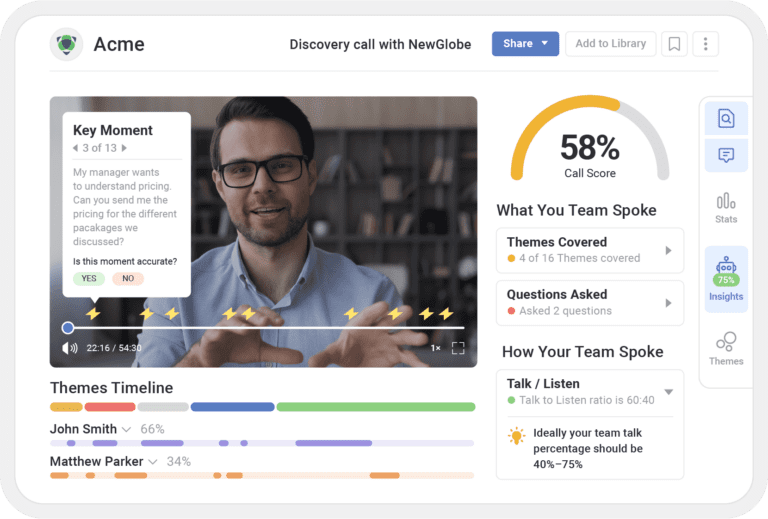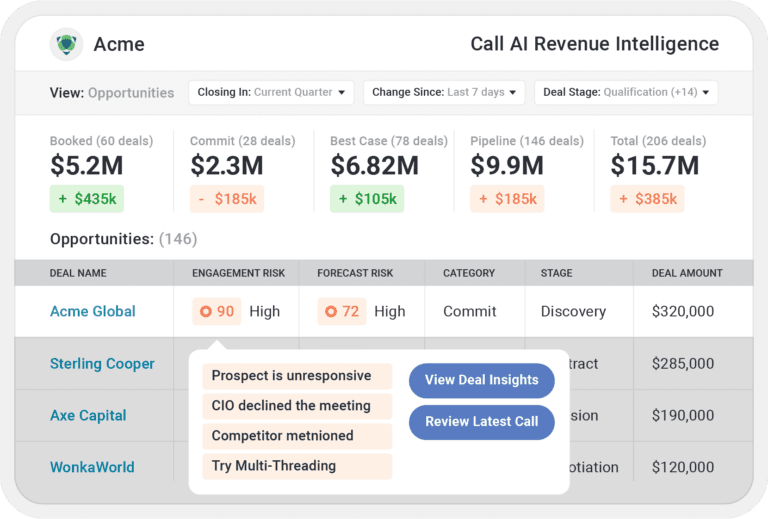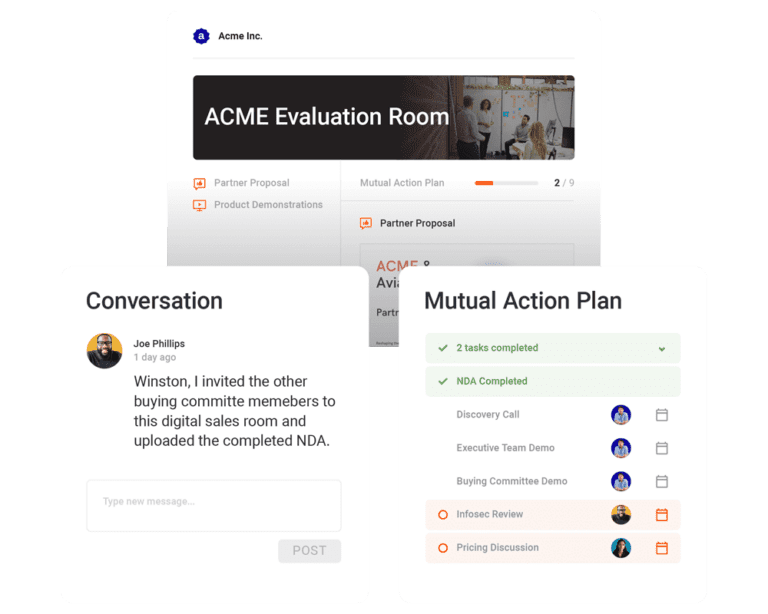Over the last few months, I’ve met with dozens of CROs and RevOps leaders to understand their biggest pain points, all of which have been amplified by the current market conditions. These companies ranged from F500s to high-growth commercial companies in markets like B2B tech, education, finance, insurance, and consumer healthcare. Most had a minimum of 25 revenue-generating reps on their team, but some had several thousand. As I learned about their challenges, it became clear there are some recurring themes when it comes to the sales technologies in their stack.
Here’s what I heard during my tour:
- “We simply don’t have enough repeatability built into our sales org.”
- “We need to get better at timing deals and knowing why they’re won or lost.”
- “One or two over-performers won’t cover our delta. We need the team to scale.”
- “Too much of our pipeline is high-risk and disengaged. We’ve got to change that.”
- “My sales team has premature presentation syndrome. How do I get them personalizing and building better business cases?”
- “An annual SKO is not enough. How do I get my team ‘microdosing’ sales training every day?”
- “We can’t keep creating enablement from scratch. It’s breaking us.”
- “How do we get managers to coach more and reps to self-improve?”
These challenges are validated by industry research. We know that the sales process has gotten more complex – 63% of purchases now have four decision-makers involved and the number of buyer interactions has jumped to more than 27. At the same time, sellers have become less productive. Only 32% of a sales reps’ time is actually spent selling and on top of that, according to our 2022-2023 Sales Enablement Outlook Report, the average organization uses more than 10+ sales tools.
But when it comes to addressing these challenges, which technologies are actually worth using and materially impact revenue? This blog post outlines where to start when you’re looking to build an efficient, seamless sales tech stack and technologies to consider.
Your sales tech stack: Where to start
The biggest mistake CROs and RevOps leaders make is that they throw tools at problems instead of first outlining their pain points, use cases, and desired workflows. This will lead to a bloated, expensive tech stack that doesn’t get used.
Instead, focus on finding solutions that address the following critical use cases:
- Know which customers to engage, when, and how
- Capture emails, calls, meetings, and contacts to get insights on how to improve buyer engagement
- Help sellers know who to follow up with, and which content to send
- Research relevant topics like products and competitors to personalize your pitch
- Effectively prepare for meetings and follow-up
Get really clear about outlining the specific things your reps need to do. Some examples include:
- Logging activities faster, easier, and more accurately (or better yet, automate it all)
- Managing and prioritizing accounts, leads, and opportunities
- Managing contacts and auto-syncing them to the CRM
- Measuring buyer engagement
- Making sense of their sales performance & coaching opportunities
- Managing and automating pipeline and forecasting
Conversation & revenue intelligence
This year, it’s all about saving time for your sellers. Conversation and revenue intelligence tools help sellers manage opportunities intuitively and update the CRM without thinking. These solutions automatically sync call notes, contacts, emails, and call recordings to systems like Salesforce so sellers can focus on active listening more.
With a conversation or revenue intelligence solution in place, it’s easier to hand over deal and account history, as well as score deal health or uncover risks within opportunities.

Forecast automation
As I mentioned, making sense of pipeline gaps and forecasting with higher accuracy are two things keeping CROs and RevOps teams up at night. These leaders need complete control of the forecasting process, and to be able to trust the data their team inputs.


With AI forecasting tools, provided by companies like our partner BoostUp.AI, AI can predict which deals will close on time or not. At the same time, it can uncover risks in your pipeline and challenges your team faces driving buyer engagement at specific “problem stages” in your sales cycle.
Buyer/seller engagement platforms
With a buyer and seller engagement solution in place, sellers send more and better emails, make more and better calls, stay focused, and win more deals. These tools guide task prioritization while capturing and matching activity to the CRM.
For example, companies like Lavendar.AI and Regis.AI use generative AI to write emails for you. At Mindtickle, we use tools like LinkedIn Navigator, ZoomIQ, DemandBase, G2 intent data, Walnut, and Databook to drive better, more personalized buyer engagement.
We also offer Digital Sales Rooms so reps can build a personalized deal room for customers filled with content, call recordings, and action plans. DSRs allow you to track which customers engaged, and what content piqued their interest.


Enablement & templates for sales methodology adoption
Most organizations have put a new sales methodology in place to drive consistency in the current market. That might include MEDDPICC, BANT, Sandler, or one of many more.
But if you don’t have the ability to properly enable your team on these methodologies and no data on who is adopting them or not, that’s a problem.
Here at Mindtickle we can see what percentage of every opportunity our sales team creates has followed our preferred sales methodology as well as information gaps. We also offer off-the-shelf templates, sales plays, and other content to enable teams around the latest methodologies.
Some additional tips to consider
If you’re looking to improve and streamline your sales tech stack, it’s important that you consider the following tips.
- Conduct a seller time assessment to see who is spending time on what topics
- Examine your current workflow and see if there is an opportunity to reduce or streamline siloed tools
- Carefully research the click path to not only access insights, but actually do something to move a deal forward, or coach a rep
- Document the unique nuances of the fields and customization within your CRM
- Aim to first capture necessary data around pipeline management, forecasting, deals, and calls
- Build playbooks and enablement that help your sellers act on data. Where possible, empower them with AI-enabled workflows.
What's in your tech stack?
Connect with our team to see how Mindtickle fits into (and might replace) some tools in your current tech stack.
Get a Demo(This post was originally published in March 2023 and was updated in November 2023. )







